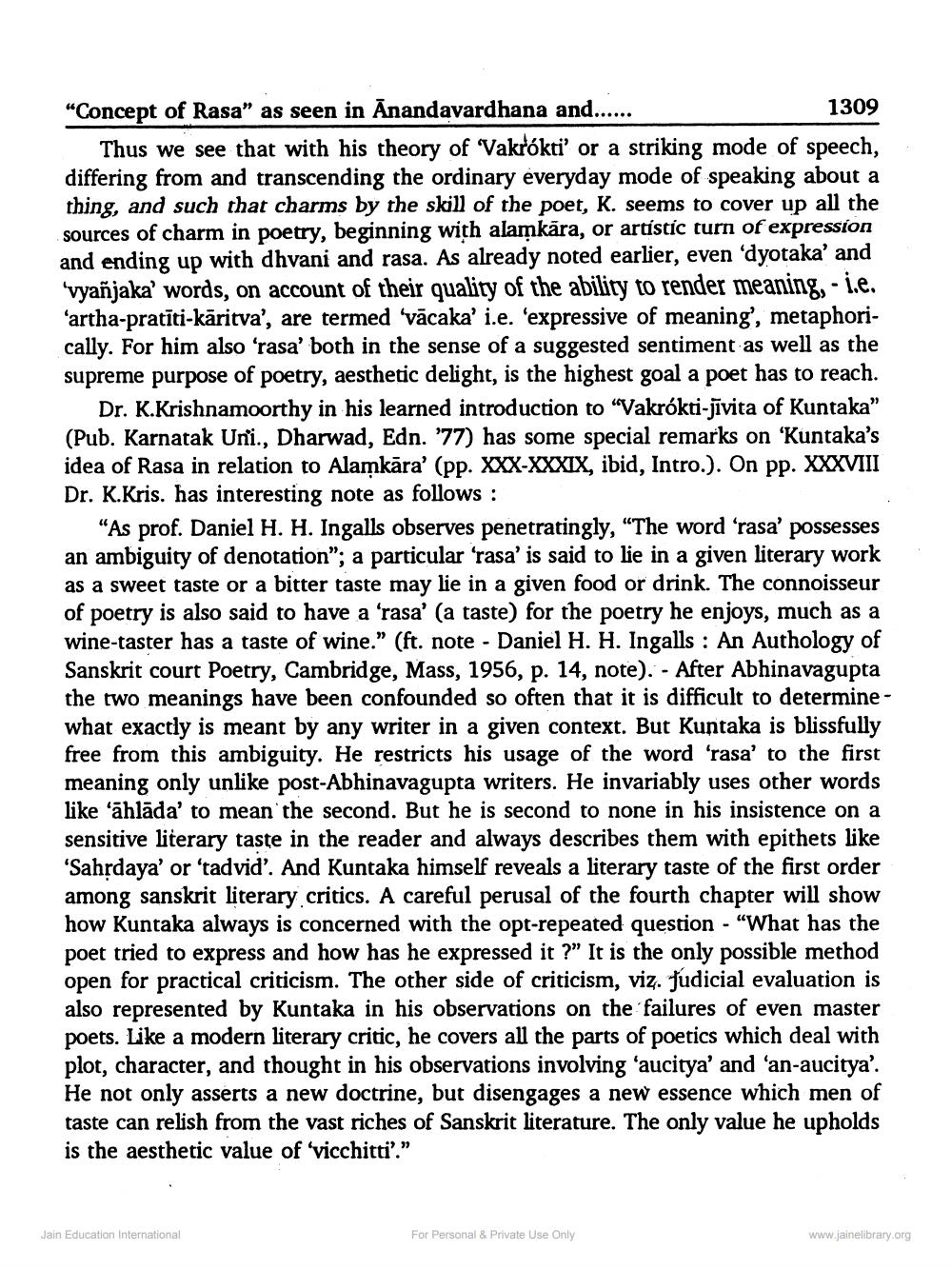________________
“Concept of Rasa” as seen in Anandavardhana and......
1309 Thus we see that with his theory of Vakrókti' or a striking mode of speech, differing from and transcending the ordinary everyday mode of speaking about a thing, and such that charms by the skill of the poet, K. seems to co sources of charm in poetry, beginning with alamkāra, or artistic turn of expression and ending up with dhvani and rasa. As already noted earlier, even 'dyotaka' and 'vyañjaka' words, on account of their quality of the ability to render meaning, - i.e. ‘artha-pratīti-kāritva', are termed 'vācaka' i.e. 'expressive of meaning', metaphorically. For him also 'rasa' both in the sense of a suggested sentiment as well as the supreme purpose of poetry, aesthetic delight, is the highest goal a poet has to reach.
Dr. K.Krishnamoorthy in his learned introduction to "Vakrókti-jivita of Kuntaka" (Pub. Karnatak Uni., Dharwad, Edn. '77) has some special remarks on 'Kuntaka's idea of Rasa in relation to Alamkāra' (pp. XXX-XXXIX, ibid, Intro.). On pp. XXXVIII Dr. K.Kris. has interesting note as follows :
“As prof. Daniel H. H. Ingalls observes penetratingly, “The word 'rasa' possesses an ambiguity of denotation"; a particular 'rasa' is said to lie in a given literary work as a sweet taste or a bitter taste may lie in a given food or drink. The connoisseur of poetry is also said to have a 'rasa' (a taste) for the poetry he enjoys, much as a wine-taster has a taste of wine.” (ft. note - Daniel H. H. Ingalls : An Authology of Sanskrit court Poetry, Cambridge, Mass, 1956, p. 14, note). - After Abhinavagupta the two meanings have been confounded so often that it is difficult to determine - what exactly is meant by any writer in a given context. But Kuntaka is blissfully free from this ambiguity. He restricts his usage of the word 'rasa' to the first meaning only unlike post-Abhinavagupta writers. He invariably uses other words like 'ahlāda' to mean the second. But he is second to none in his insistence on a sensitive literary taste in the reader and always describes them with epithets like 'Sahrdaya' or 'tadvid'. And Kuntaka himself reveals a literary taste of the first order among sanskrit literary critics. A careful perusal of the fourth chapter will show how Kuntaka always is concerned with the opt-repeated question - "What has the poet tried to express and how has he expressed it ?" It is the only possible method open for practical criticism. The other side of criticism, viz. fudicial evaluation is also represented by Kuntaka in his observations on the failures of even master poets. Like a modern literary critic, he covers all the parts of poetics which deal with plot, character, and thought in his observations involving 'aucitya' and 'an-aucitya'. He not only asserts a new doctrine, but disengages a new essence which men of taste can relish from the vast riches of Sanskrit literature. The only value he upholds is the aesthetic value of 'vicchitti'."
Jain Education International
For Personal & Private Use Only
www.jainelibrary.org




